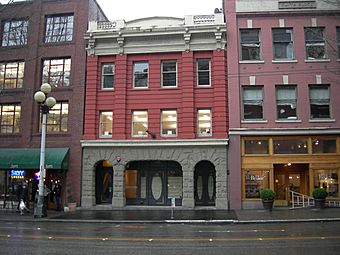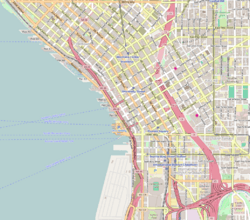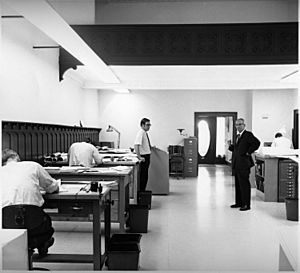Butterworth Building facts for kids
Quick facts for kids |
|
|
Butterworth Building
|
|

Butterworth Building in Seattle
|
|
| Location | 1921 First Ave. Seattle, Washington 98101 |
|---|---|
| Built | October 1, 1903 |
| Architect | John Graham, Sr. |
| Architectural style | Late Victorian |
| NRHP reference No. | 71000873 |
| Added to NRHP | 14 May 1971 |
The Butterworth Building is a historic building located at 1921 First Avenue in Seattle, Washington. It was originally built in 1903 for Butterworth & Sons, a company that provided funeral services. They moved to a larger location in 1923.
This building is special because it was the first building in Seattle made specifically for funeral services. It was designed to offer everything needed, from preparing bodies to selling coffins. The building even had the first elevator on the West Coast of the United States, used to move bodies. People at the time called it "the most complete establishment of its kind in the United States."
The Butterworth Building is on a steep hill. This means it looks like it has three stories from the First Avenue side, but five stories from Post Alley at the back. The building is known for its beautiful inside, with stained mahogany wood, art glass, and fancy plaster. It is listed on the National Register of Historic Places, which means it's an important historical site. Today, the McAleese Family has owned the building since 2005.
The basement of the building is now home to Kells Irish Restaurant & Pub. While some stories say this area was once used for embalming or cremation, old records from 1904 show it actually held the building's heating system, stables for horses, and storage for funeral wagons.
The Butterworth Building is also famous for its many ghost stories. In 2010, it was even featured on a TV show called Ghost Adventures.
Contents
Building Layout and History
The Butterworth Building was carefully designed to serve its original purpose. Each floor had a specific use.
Upper Floors for Living and Display
The very top floor of the building had three apartments. These were for the employees of the funeral home to live in. This floor had its own separate entrance from First Avenue.
Below the employee apartments was a floor dedicated to showing funeral items. Here, visitors could see different types of coffins, including smaller ones for children. There was also a room with burial clothes for women. A private room was available for families to meet and discuss arrangements. The main coffin showroom had a view of Elliott Bay. In 1904, coffins ranged from $25 to $200, and burial clothes from $4 to $125. This wide range of prices meant the business could serve both wealthy and less wealthy families. Families who wanted to stay with their loved ones' bodies before the funeral could use private rooms without extra cost.
Main Floor and Chapel
The main floor of the building faced First Avenue. This floor contained the main offices, rooms for preparing bodies, and a "utensil room" for storing items like canopies and rugs used in services. These rooms were accessed through the building's main entrance.
A separate entrance led to a large funeral chapel. This chapel could hold 150 people on the main floor and 50 more in a balcony. It also had a separate balcony for a choir. Next to the chapel was a room for clergy and family, which could hold about 15 people. This room also had a private bathroom. On this floor, there was also a special showroom with very expensive coffins, some costing as much as $890 in 1904.
Lower Levels and Current Use
Below the main floor, but still above the Post Alley street level, was a "stock room." This room had fireproof vaults where bodies could be stored safely for longer periods. This was very important in Seattle at the time, as there was no other place like it in the city.
The very bottom level, which is at the same height as Post Alley, housed the building's heating system. It also had stables for horses and a storage area for funeral wagons. Since 1983, the basement and the stock room (which is now a private banquet room) have been home to the McAleese family's Kells Irish Restaurant and Pub.
Images for kids





